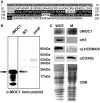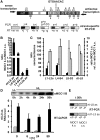The mTERF protein MOC1 terminates mitochondrial DNA transcription in the unicellular green alga Chlamydomonas reinhardtii
- PMID: 23649833
- PMCID: PMC3711419
- DOI: 10.1093/nar/gkt313
The mTERF protein MOC1 terminates mitochondrial DNA transcription in the unicellular green alga Chlamydomonas reinhardtii
Abstract
The molecular function of mTERFs (mitochondrial transcription termination factors) has so far only been described for metazoan members of the protein family and in animals they control mitochondrial replication, transcription and translation. Cells of photosynthetic eukaryotes harbour chloroplasts and mitochondria, which are in an intense cross-talk that is vital for photosynthesis. Chlamydomonas reinhardtii is a unicellular green alga widely used as a model organism for photosynthesis research and green biotechnology. Among the six nuclear C. reinhardtii mTERF genes is mTERF-like gene of Chlamydomonas (MOC1), whose inactivation alters mitorespiration and interestingly also light-acclimation processes in the chloroplast that favour the enhanced production of biohydrogen. We show here from in vitro studies that MOC1 binds specifically to a sequence within the mitochondrial rRNA-coding module S3, and that a knockout of MOC1 in the mutant stm6 increases read-through transcription at this site, indicating that MOC1 acts as a transcription terminator in vivo. Whereas the level of certain antisense RNA species is higher in stm6, the amount of unprocessed mitochondrial sense transcripts is strongly reduced, demonstrating that a loss of MOC1 causes perturbed mitochondrial DNA (mtDNA) expression. Overall, we provide evidence for the existence of mitochondrial antisense RNAs in C. reinhardtii and show that mTERF-mediated transcription termination is an evolutionary-conserved mechanism occurring in phototrophic protists and metazoans.
Figures






Similar articles
-
Impaired Mitochondrial Transcription Termination Disrupts the Stromal Redox Poise in Chlamydomonas.Plant Physiol. 2017 Jul;174(3):1399-1419. doi: 10.1104/pp.16.00946. Epub 2017 May 12. Plant Physiol. 2017. PMID: 28500267 Free PMC article.
-
The nucleus-encoded protein MOC1 is essential for mitochondrial light acclimation in Chlamydomonas reinhardtii.J Biol Chem. 2004 Nov 26;279(48):50366-74. doi: 10.1074/jbc.M408477200. Epub 2004 Sep 23. J Biol Chem. 2004. PMID: 15448140
-
A Member of the Arabidopsis Mitochondrial Transcription Termination Factor Family Is Required for Maturation of Chloroplast Transfer RNAIle(GAU).Plant Physiol. 2015 Sep;169(1):627-46. doi: 10.1104/pp.15.00964. Epub 2015 Jul 7. Plant Physiol. 2015. PMID: 26152711 Free PMC article.
-
Chlamydomonas reinhardtii as the photosynthetic yeast.Annu Rev Genet. 1995;29:209-30. doi: 10.1146/annurev.ge.29.120195.001233. Annu Rev Genet. 1995. PMID: 8825474 Review.
-
Respiratory-deficient mutants of the unicellular green alga Chlamydomonas: a review.Biochimie. 2014 May;100:207-18. doi: 10.1016/j.biochi.2013.10.006. Epub 2013 Oct 15. Biochimie. 2014. PMID: 24139906 Review.
Cited by
-
Control of organelle gene expression by the mitochondrial transcription termination factor mTERF22 in Arabidopsis thaliana plants.PLoS One. 2018 Jul 30;13(7):e0201631. doi: 10.1371/journal.pone.0201631. eCollection 2018. PLoS One. 2018. PMID: 30059532 Free PMC article.
-
Impaired Mitochondrial Transcription Termination Disrupts the Stromal Redox Poise in Chlamydomonas.Plant Physiol. 2017 Jul;174(3):1399-1419. doi: 10.1104/pp.16.00946. Epub 2017 May 12. Plant Physiol. 2017. PMID: 28500267 Free PMC article.
-
How to build a ribosome from RNA fragments in Chlamydomonas mitochondria.Nat Commun. 2021 Dec 9;12(1):7176. doi: 10.1038/s41467-021-27200-z. Nat Commun. 2021. PMID: 34887394 Free PMC article.
-
Genome-Wide Identification and Characterization of the mTERF Gene Family in Spinach and the Role of SomTERF5 in Response to Heat Stress.Plants (Basel). 2025 May 22;14(11):1570. doi: 10.3390/plants14111570. Plants (Basel). 2025. PMID: 40508244 Free PMC article.
-
Genome-Wide Identification and Characterization of the Mitochondrial Transcription Termination Factors (mTERFs) in Capsicum annuum L.Int J Mol Sci. 2019 Dec 31;21(1):269. doi: 10.3390/ijms21010269. Int J Mol Sci. 2019. PMID: 31906076 Free PMC article.
References
-
- Asin-Cayuela J, Gustafsson CM. Mitochondrial transcription and its regulation in mammalian cells. Trends Biochem. Sci. 2007;32:111–117. - PubMed
-
- Lipinski KA, Kaniak-Golik A, Golik P. Maintenance and expression of the S. cerevisiae mitochondrial genome—from genetics to evolution and systems biology. Biochim. Biophys. Acta. 2010;1797:6–7. - PubMed
-
- Vahrenholz C, Riemen G, Pratje E, Dujon B, Michaelis G. Mitochondrial DNA of Chlamydomonas reinhardtii: the structure of the ends of the linear 15.8-kb genome suggests mechanisms for DNA replication. Curr. Genet. 1993;24:241–247. - PubMed
Publication types
MeSH terms
Substances
LinkOut - more resources
Full Text Sources
Other Literature Sources

